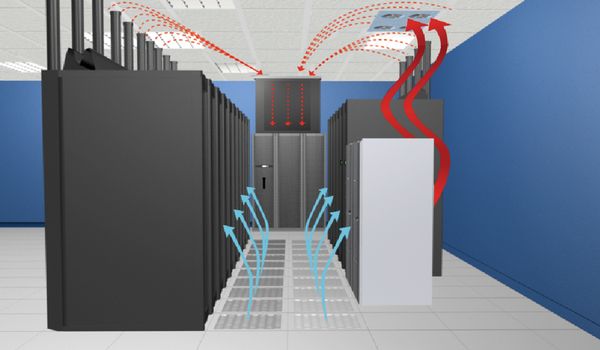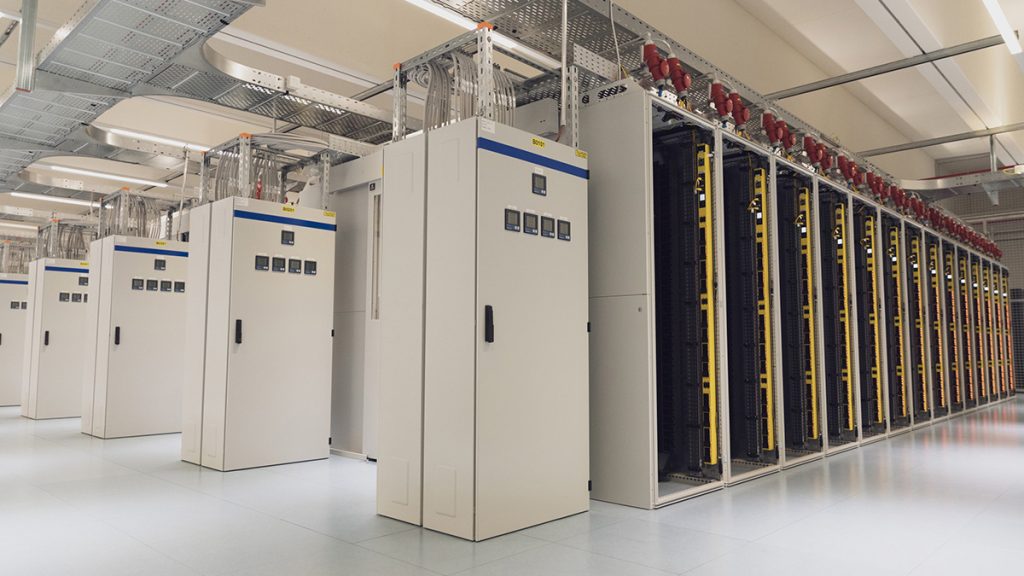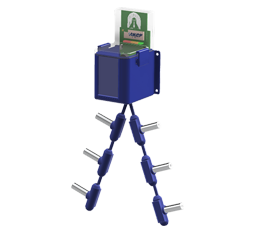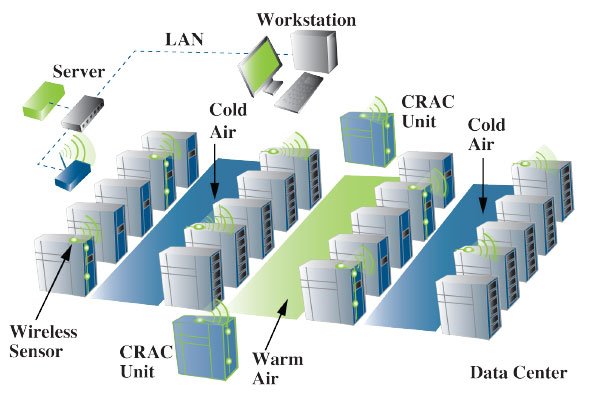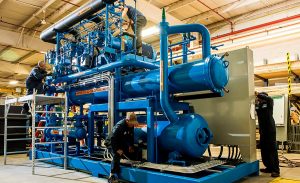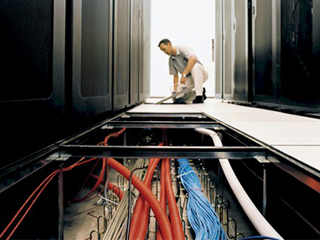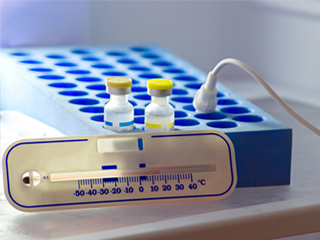Power and cooling are the two most fundamental elements of data centers. An average size data center consumes a large amount of power. A large chunk of this power is used in cooling systems. Cooling systems keep the facility functioning, as they remove the waste heat produced by the IT equipment.
Traditional data centers use a variety of cooling techniques. A combination of raised floors, CRAC / CRAH units is one example of a data center cooling setup. Meanwhile, modern data centers utilize innovative cooling technologies. From basic fans to complex heat transfer technologies like integrating with AI, edge, and cloud computing to manage cooling systems.
In this article, we look at the traditional data center cooling techniques of yesterday and the advanced cooling technologies of today. We will also discuss the utilization of edge and cloud technologies in data center cooling. Finally, we will look at the future of data center cooling.
Legacy Data Center Cooling

Photo Credit: Uptime Institute Journal
For many years, the raised floor technique has been deployed in data centers. Raised floors are used to deliver cold air to the servers. The cold air from the CRAC / CRAH flood the area under the red floor with cold air. As the air is fed in it pressurizes the plenum. Perforated floor tiles allow cold air to leak out. The perforated tiles are usually located either in cold aisles, or infant of each rack. After moving through the servers, the waste heat returns to the CRAC / CRAH units to be cooled again.
Typically, the CRAC units’ return temperature is used to manage the cooling system. The CRAC unit fans operate at a constant speed. It also has a humidifier that produces steam. This has been a typical design in data centers for many years. It is still widely employed today. Raised floors are still considered a basic element in a data center infrastructure.
The legacy design in data centers depends on the principle of comfort cooling. That is, bringing a small amount of conditioned air. Then allowing it to combine with the larger amount of air available in space to achieve the right temperature. The legacy design is ideal for low-density IT equipment. Since low densities can handle poor efficiency and uneven cooling.
But now, the demand for high density data centers is increasing. This means more efficient cooling systems are needed.
Datacenter Cooling Technology Today

Photo Credit: www.gea.com
Data center demand is increasing, be it a small edge data centers, an enterprise, or hyperscale facility. All types of data centers depend on thermal management to operate. But their demands differ based on their sizes. Cloud technology is also utilized in today’s data center cooling. Businesses are now switching to intelligent environmental sensor systems to monitor, control and optimize their data centers.
In 2014, a 3 MW data center was considered a large facility. But now, 10 MW is the average facility size for hyperscale and enterprise data centers. Colocation and hyperscale customers are concerned with high-volume custom solutions that can address their needs. It offers lower costs, fewer risks, and faster speed to market.
Multi-story data centers are also becoming a trend. This reduces the expense of the real estate. It allows other cooling systems to be applied in other areas. Modern data centers can also tolerate a slightly higher temperature as advised by ASHRAE. From 18°C or 64.4°F to 27°C or 80.6°F. This means that operators can increase supply temperatures without worrying about damage.
-
Utilizing Edge And Cloud Technology
The edge and cloud technology are now widely used in data centers. These can be seen in the form of the Internet of Things (IoT) and 5G networks. Most businesses consider edge as the vital element of data centers. Since these systems are responsible for increasing revenue. As well as data storage.
Edge cooling systems can handle airflow, humidity, and temperature. You may opt for a remote monitoring system with an IoT mobile app and an online portal. This allows you to monitor and manage your facility anytime and anywhere. There are edge systems that can be mounted on walls and ceilings. So, you do not have to worry about space.
-
Eliminating Water For Cooling
As you know, water consumption is also a big concern in the data center industry. Although water is an effective cooling medium, it is still a limited resource. Eliminating water in cooling systems is still controversial in the industry. Hence, liquid cooling technologies may not be an option for other businesses.
Water treatments, costs, and availability can be restricting. Other big data centers are switching to water-free cooling systems. To eliminate water consumption and head towards their sustainability goals.
-
Utilizing Pumped Refrigerants

Photo Credit: www.foodengineeringmag.com
Pumped refrigerant systems are another trend in data center cooling. When optimized, it can increase energy savings by up to 50%. As well as save up to 6.75 million gallons of water per year for a 1 MW data center. Relative to a chilled water cooling system that uses vast amounts of water. It is a rather sustainable technology that can still deliver efficiency.
Pumped refrigerant is also cost-saving. It does not need additional chillers or cooling towers. It is optimized with the help of ambient temperatures and IT load. Instead of fixed outdoor temperature setpoints. Allowing data centers to enjoy 100% potential economization hours.
Direct evaporative cooling systems are now employed in hyperscale facilities. This system uses cool, outside air as the main cooling material usually throughout the year. It also uses a wet media pad to cool the incoming air when there are higher ambient conditions.
Direct evaporative design is a sustainable option for cooling systems. It also costs lower since it uses relatively lower amounts of water. As well as decreased energy consumption. But take note that this system may not be applicable for all data centers. Some facilities need a much wider operating window for temperature and humidity.
Datacenter Cooling In The Future
With today’s technology, the world is only ever advancing. In data centers, applications like facial recognition and data analytics are evolving. Even server processors are also becoming more advanced. This provides an opportunity for better cooling systems. Hopefully, cooling systems in the future will become truly sustainable.
Pumped refrigerant systems and free cooling systems are also likely to advance. Lowering costs and bringing higher efficiency. Processors and servers will also need innovation in terms of their thermal management.
Cooling systems will always be a mission-critical component in data centers. Choose the right cooling systems for your facility. Take advantage of the modern techniques and technologies we have today. This will help you improve efficiency as well as promote sustainability in your data center.
Keeping Your Cool In Data Center
These systems are the primary means of keeping data center equipment cool in a variety of operations and environments. They all, however, necessitate constant supervision.
Datacenter infrastructure management (DCIM) is a solution to this problem. Thermal sensors and infrared detectors are used to produce a map of hot regions in a data center. Computational fluid dynamics (CFD) study allows for “what-if?” scenarios to see how different cooling flows and input temperatures will affect different systems.
Monitoring with DCIM in place will quickly identify hot spots, allowing systems to be slowed down, switched off, and replaced as needed. The unexpected emergence of a hot spot often signifies an impending equipment failure; being able to detect this before it occurs i

Wireless Cabinet Thermal Map
mproves system uptime and availability.
Wireless Thermal Mapping of IT Cabinets
Wireless thermal mapping of your IT cabinets. With 3x Temperature sensors at the front and 3x at the rear, it monitors airflow intake and exhaust temperatures, as well as provide the temperature differential between the front and rear of the cabinet (ΔT) Wireless Thermal maps work with all Wireless Tunnel™ Gateways.
Thermal Maps are integrated with AKCPro Server DCIM software in our cabinet rack map view. For more details on the cabinet, thermal map sensors view here.
AKCP Airflow Sensor
The AKCP Pro airflow sensor is designed for systems that generate heat in the course of their operation and a steady flow of air is necessary to dissipate this heat generated. System reliability and safety could be jeopardized if this cooling airflow stops.
The Airflow sensor is placed in the path of the air stream, where the user can monitor the status of the flowing air. The airflow sensor is not a precision measuring instrument. This device is meant to measure the presence or the absence of airflow.
Conclusion
Data centers have become more complicated in recent years. The influx of data in recent years has resulted in the influx of demand. A data center is a fragile structure that houses various IT systems and equipment. Hence, it needs careful and efficient power and cooling systems. As IT systems generate heat, it is essential to remove this heat waste. Cooling technology is designed to keep the correct climate for IT activities.
Today, there are many cooling technologies that you may utilize in your facility. You may combine different cooling designs and methods. To achieve an efficient system perfect for your facility. Take advantage of the advanced technologies we have today. Especially if you have the budget to do so. Take note that your data center is the heart of your organization. Trust nothing but the best systems for your facility.
Reference Links:
https://www.vxchnge.com/blog/data-center-cooling-technology
https://journal.uptimeinstitute.com/a-look-at-data-center-cooling-technologies/
https://www.hpac.com/technology/article/20929771/technology-pushes-data-center-cooling-to-edge-and-beyond
